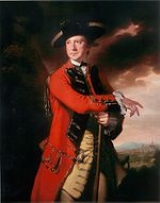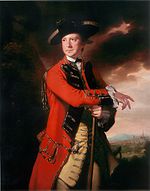
Hope Baronets
Encyclopedia

The Hope Baronetcy, of Craighall in the County of Fife, created in the Baronetage of Nova Scotia on 19 February 1628 for the Scottish lawyer Thomas Hope. The sixth Baronet assumed the additional surname of Bruce, a surname also held by the seventh Baronet. The latter sat as Member of Parliament
Member of Parliament
A Member of Parliament is a representative of the voters to a :parliament. In many countries with bicameral parliaments, the term applies specifically to members of the lower house, as upper houses often have a different title, such as senate, and thus also have different titles for its members,...
for Clackmannan and Kinross. The eleventh Baronet was Conservative
Conservative Party (UK)
The Conservative Party, formally the Conservative and Unionist Party, is a centre-right political party in the United Kingdom that adheres to the philosophies of conservatism and British unionism. It is the largest political party in the UK, and is currently the largest single party in the House...
Member of Parliament for Midlothian
Midlothian (UK Parliament constituency)
Midlothian in Scotland, is a county constituency of the House of Commons of the Parliament of the United Kingdom. It elects one Member of Parliament by the first-past-the-post voting system....
. The sixteenth Baronet sat as Member of Parliament for Midlothian and Midlothian and Peebles North
Midlothian and Peebles Northern (UK Parliament constituency)
Midlothian and Peebles Northern was a county constituency represented in the House of Commons of the Parliament of the United Kingdom from 1918 until 1950...
. The present Baronet is Chief of Clan Hope
Clan Hope
-Origins of the clan:Hope is a native Scottish name. However, in middle English it means 'small valley'. Another suggestion is that it derives from 'oublon', which is French for 'hop' and could be from the family de H'oublons of Picardy....
.
Charles Hope, 1st Earl of Hopetoun
Charles Hope, 1st Earl of Hopetoun
Charles Hope, 1st Earl of Hopetoun KT was a Scottish nobleman.He was the son of John Hope of Hopetoun, grandson of Sir Thomas Hope, 1st Baronet of Craighall, Fife. John Hope purchased the barony of Niddry Castle from the Earl of Winton around 1680...
, ancestor of the Marquesses of Linlithgow
Marquess of Linlithgow
Marquess of Linlithgow, in the County of Linlithgow or West Lothian, is a title in the Peerage of the United Kingdom. It was created in 1902 for John Hope, 7th Earl of Hopetoun....
, was the grandson of Sir James Hope, sixth son the first Baronet of Craighall. Sir Archibald Hope, second son of the second Baronet, was a Lord of Session as Lord Rankeillour. His grandson John Hope
John Hope (botanist)
John Hope was a Scottish physician and botanist. He is best known as an early supporter of Carl Linnaeus's system of classification, largely because he published very little of the research that might have made him a name in plant physiology....
was a surgeon and botanist. John Edward Hope, great-grandson of Captain Robert Hope, grandson of Sir Archibald Hope, Lord Rankeillour, was a Major-General in the British Army
British Army
The British Army is the land warfare branch of Her Majesty's Armed Forces in the United Kingdom. It came into being with the unification of the Kingdom of England and Scotland into the Kingdom of Great Britain in 1707. The new British Army incorporated Regiments that had already existed in England...
. Archibald Hugh Hope, son of Hugh Hope, fourth son of the ninth Baronet, was a Major-General in the British Army
British Army
The British Army is the land warfare branch of Her Majesty's Armed Forces in the United Kingdom. It came into being with the unification of the Kingdom of England and Scotland into the Kingdom of Great Britain in 1707. The new British Army incorporated Regiments that had already existed in England...
.
The Hope Baronetcy, of Kerse in the County of Stirling, was created in the Baronetage of Nova Scotia on 30 May 1672 for Alexander Hope. The title became extinct on the death of the fourth Baronet in c. 1794.
The Hope Baronetcy, of Kirkliston, was created in the Baronetage of Nova Scotia on 1 March 1698 for William Hope. The title became dormant on the death of the third Baronet in 1763. According to some sources John Hope, 2nd Earl of Hopetoun
John Hope, 2nd Earl of Hopetoun
John Hope, 2nd Earl of Hopetoun was the son of Charles Hope, 1st Earl of Hopetoun and Lady Henrietta Johnstone....
, succeeded to the title.
The Hope Baronetcy, of Kinnettles in the County of Angus, was created in the Baronetage of the United Kingdom on 13 January 1932 for the Scottish Unionist politician Harry Hope. The presumed third Baronet never successfully proved his succession and was never on the Official Roll of the Baronetage. The title became extinct on his death in 1993.
Hope Baronets, of Craighall (1628)
- Sir Thomas Hope, 1st Baronet (d. 1646)
- Sir John Hope, 2nd Baronet (c. 1605-1654)
- Sir Thomas Hope, 3rd Baronet (1633-c. 1660)
- Sir Thomas Hope, 4th Baronet (d. c. 1686)
- Sir William Hope, 5th Baronet (d. c. 1707)
- Sir Thomas Bruce-Hope, 6th Baronet (d. 1729)
- Sir John Bruce-Hope, 7th Baronet (c. 1684-1766)
- Sir Thomas Hope, 8th Baronet, (d. 1771)
- Sir Archibald Hope, 9th Baronet (1735–1794)
- Sir Thomas Hope, 10th Baronet (1768–1801)
- Sir John Hope, 11th Baronet (1781–1853)
- Sir Archibald Hope, 12th Baronet (1808–1883)
- Sir John David Hope, 13th Baronet (1809–1892)
- Sir William Hope, 14th Baronet (1819–1898)
- Sir Alexander Hope, 15th Baronet (1824–1918)
- Sir John Augustus Hope, 16th Baronet (1869–1924)
- Sir Archibald Philip Hope, 17th Baronet (1912–1987)
- Sir John Carl Alexander Hope, 18th Baronet (1939–2007)
- Sir Alexander Archibald Douglas Hope, 19th Baronet (b. 1969)
Hope Baronets, of Kerse (1672)

- Sir Alexander Hope, 1st Baronet (1637–1673)
- Sir Alexander Hope, 2nd Baronet (1663–1719)
- Sir Alexander Hope, 3rd Baronet (1697–1749)
- Sir Alexander Hope, 4th Baronet (1728–1794)
Hope Baronets, of Kirkliston (1698)
- Sir William Hope, 1st Baronet (1660–1724)
- Sir George Hope, 2nd Baronet (c. 1685-1729)
- Sir William Hope, 3rd Baronet (c. 1726-1763)
Hope Baronets, of Kinnettles (1932)
- Sir Harry Hope, 1st Baronet (1865–1959)
- Sir James Hope, 2nd Baronet (1898–1979)
- Sir Robert Holms-Kerr Hope, 3rd Baronet (1900–1993)
See also
- Marquess of LinlithgowMarquess of LinlithgowMarquess of Linlithgow, in the County of Linlithgow or West Lothian, is a title in the Peerage of the United Kingdom. It was created in 1902 for John Hope, 7th Earl of Hopetoun....
- Baron GlendevonBaron GlendevonBaron Glendevon, of Midhope in the County of Linlithgow, is a title in the Peerage of the United Kingdom. It was created in 1964 for the Conservative politician Lord John Hope. He was the younger twin son of Victor Hope, 2nd Marquess of Linlithgow. the title is held by his younger son, the third...
- Baron RankeillourBaron RankeillourBaron Rankeillour, of Buxted in the County of Sussex, is a title in the Peerage of the United Kingdom. It was created in 1932 for the Conservative politician James Hope. He was the grandson of General Sir Alexander Hope, fourth son of John Hope, 2nd Earl of Hopetoun...
- Hope-Dunbar BaronetsHope-Dunbar BaronetsThe Dunbar, later Hope-Dunbar Baronetcy, of Baldoon, is a title in the Baronetage of Nova Scotia. It was created on 13 October 1664 for David Dunbar, with remainder to his heirs male and tailzie. The baronetcy became dormant on his death in 1686. The title remained dormant until 1916, when it was...

